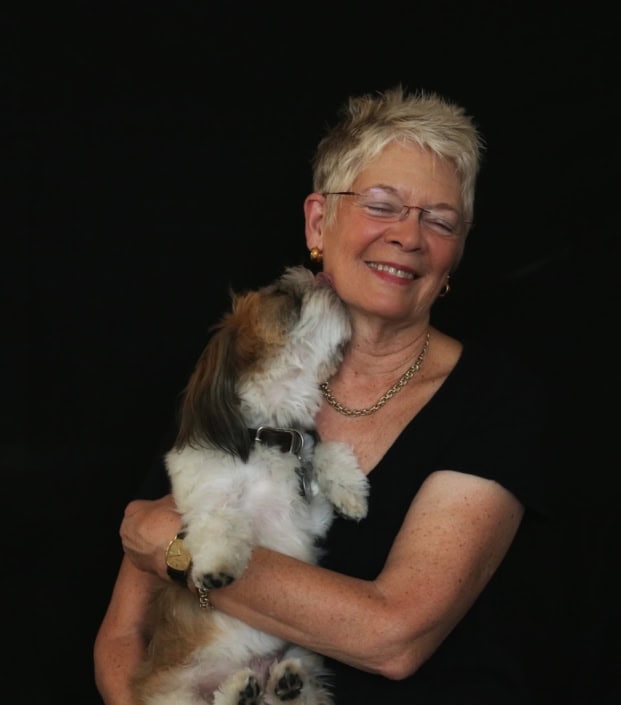Not a Typical Tuesday: My Transverse Myelitis Journey
By Flo Bartell
The night of Tuesday, May 2, 2017, changed the course I expected the remaining years of my life to take, but I did not fully understand that then. I couldn’t know this was a forever thing.
Even now, sometimes when I climb out of bed in the morning, I expect to be my former, feisty self. Then my feet hit the floor, nerves in my left leg jolt, my right leg needs a few seconds to adjust to bearing weight, and I hold on to be sure I am steady before I start walking. What? Is this still for real?
Understanding and acceptance take time, and I am still working on it. Of my onset of transverse myelitis (TM), most say, “You must have been terrified!” No, I wasn’t. I was certainly surprised, and the pain was excruciating, but I took the role of observer, a “Wow! Look at that!” approach.
While sleep evaded me as that May night eased into the morning, I began to see how symptoms had developed, even though, at that time, I still couldn’t see the whole picture. With the help of my iPad, I did understand that I had several known risk factors for TM…autoimmune disease, vaccines, overseas travel, and a viral infection.
In October and November of 2016, I was given a series of vaccinations in preparation for an upcoming trip to India. After that, I just did not feel ‘right’ and experienced unexplained weight gain. At the time, I blamed my long hours in my art studio to finish work for an upcoming exhibit. I previously had been diagnosed with what my rheumatologist finally called a “non-life-threatening, lupus-like autoimmune disorder” that causes joint pain and, at times, a general feeling of being unwell. Other than that, I was almost never sick and had never experienced unexpected reactions to vaccines. I didn’t suspect that vaccines contributed to the way I was feeling, and I still do not know for sure that they did. After my exhibit, at the end of January, I left for India with a group of artists.
On the first day of the tour, I walked about six miles as we explored paper and fabric-making factories…not bad for a then-76-year-old. Throughout that trip, though, my energy began to fade, and by the end of our time there, I could barely keep up with our activities. On the trip home, I felt like I was getting a cold but thought maybe it was from the smog in New Delhi.
In March, about a month after returning home, I saw my primary physician to discuss a strange discomfort in my chest. The slight pain and feeling of heaviness seemed, to me, to be esophageal or possibly cardiac issues. My doctor didn’t find anything wrong and sent me to my cardiologist, who also ruled out any new problems.
One day in mid-April, I went to the emergency room with pain that seemed like it could be extreme heartburn. The doctor could not find the cause of my pain, and my discomfort eased within a few hours. On the night of April 27, I felt intense pain in my upper right arm. I blamed it on lifting heavy artwork and flats of water needed for a reception the following night. Though my pain seemed extraordinary that Thursday night, I took ibuprofen, brushed away any thoughts of a serious health problem, and went to bed. Miraculously I slept and by morning the pain had disappeared. I felt well and enjoyed my art reception that night.
A few days later on the evening of May 2, however, the pain in my right arm returned with a vengeance, and my legs began to buckle. My husband supported me as I wobbled to the car. By the time we arrived at the ER 20 minutes later, I could not stand and could barely sign my name. When I reached the exam room, my right side was completely paralyzed. Seeing ‘hemiplegic, drop foot’ on my chart was a bit disconcerting. Thankfully, the neurologist on call immediately ordered an MRI and then told me that the scan confirmed his suspicion that I had TM with a lesion between C5 and C7. He also said that he expected a full recovery. I don’t know if he really believed that, but it was the right thing to say to me. It offered hope and gave me my assignment…I had work to do.
I was admitted to the hospital, and before daylight, an IV was pumping in large doses of Solu-Medrol®, an anti-inflammatory glucocorticoid. I stayed in the hospital five days before transferring to an excellent acute inpatient rehabilitation facility to receive intense physical therapy. Two weeks after my emergency room visit, I was able to go home using a foot brace and wheelchair or walker, depending on the events of the day and my energy level. I began outpatient physical therapy a few days later. I went to therapy two days a week and followed the home routine my therapist designed for me.
By late August I could walk without assistance–not even using the foot brace–and I could drive! I still experienced crushing fatigue, nerve pain, and bathroom emergencies, so life was different. But I was thrilled to be able to carry on most normal activities. Of course, roads to recovery are usually curvy, and mine has been no exception. I have had ups and downs and with each year age has taken increasing tolls. Weakness caused by TM changed my gait and exacerbated pre-existing spinal degenerative problems, so I now use arm crutches when I need to navigate uneven surfaces and a walker or wheelchair for some activities.
Fatigue and weakness, spasticity, pain, mobility issues, weight gain, and bathroom emergencies aside, I feel grateful every day. I take a low dose of Lyrica®, a nerve pain medication, each night to help alleviate some of my symptoms. I can still enjoy working and teaching in my art studio and playing my ukulele or guitar for pleasure as well as well as for hand therapy. Thankfully, my right hand has almost fully recovered, and I can still drive for short-distance errands. I periodically return to physical therapy and try to continue with home exercises. With helpers to do heavy household and gardening chores, I live somewhat independently. Life is definitely different than I expected it to be, but it is good.
I am grateful beyond words for my neurologist, Dr. Rajan Patel, who recognized my symptoms and prescribed proper treatment. I feel certain that without his prompt diagnosis my quality of life would not be what it is today. I am fortunate that I had access to physical therapy in both facilities and beyond, and I appreciate all those who helped me in 2017 as well as those who continue to help me on my journey.
Our “In Their Own Words” blog posts represent the views of the author of the blog post and do not necessarily represent the views of SRNA.





